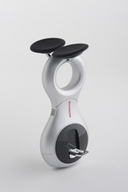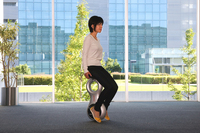First U.S. Demonstration of Honda U3-X Personal Mobility Prototype in New York - VIDEO ENHANCED
NEW YORK - April 6, 2010: Honda today held the first U.S. demonstration of the company's U3-X personal mobility prototype, first introduced at the Tokyo Motor Show in October of last year. The three-day debut event will run through April 8 at the New York Marriott Marquis Hotel in Times Square. A second demonstration will be held April 13-15, at the 2010 Society of Automotive Engineers (SAE) World Congress in Detroit, Michigan.
 |
With U3-X Honda rethinks the concept of personal mobility, providing the rider with freedom of movement in any direction - forward, backward, sideways and diagonally - by simply leaning slightly in the desired direction. The lightweight and compact one-wheeled device also features a foldable seat and retractable footrests. A lithium-ion battery pack provides power for up to one-hour of use and can be recharged by plugging in to a conventional household or office 120-volt power outlet.
Weighing roughly 22 pounds, U3-X uses an advanced Honda proprietary balance-control system which derives from its research into human walking dynamics for the development of the ASIMO bi-pedal humanoid robot. To realize full freedom of movement in all directions, the U3-X also employs the world's first omni-directional driving wheel system (Honda Omni Traction Drive System) which utilizes a series of concentrically mounted wheels - a larger, forward and backward moving inner wheel and a series of smaller sideways moving outer wheels. Diagonal motion is achieved when both forward and sideways moving wheels operate in tandem.
In addition, the compact size and one-wheel-drive design of U3-X was intended to provide user-friendly and pedestrian-friendly operation with low-mounted foot pedals that make it easy for the rider to reach the ground, and a seat height that places the rider at approximately the same eye-level as other people.
Click PLAY to watch video
As a company that values mobility, Honda began research into robotics in 1986 and walking devices in 1999, culminating in the development of ASIMO, the world's most advanced bi-pedal humanoid robot. The cumulative study of human walking and balance control has also led to the development of numerous other experimental technologies including the U3-X personal mobility device as well as Honda's Stride Management Assist and Bodyweight Support Assist walking assist devices - all geared toward further advancing human mobility through technological innovation.



